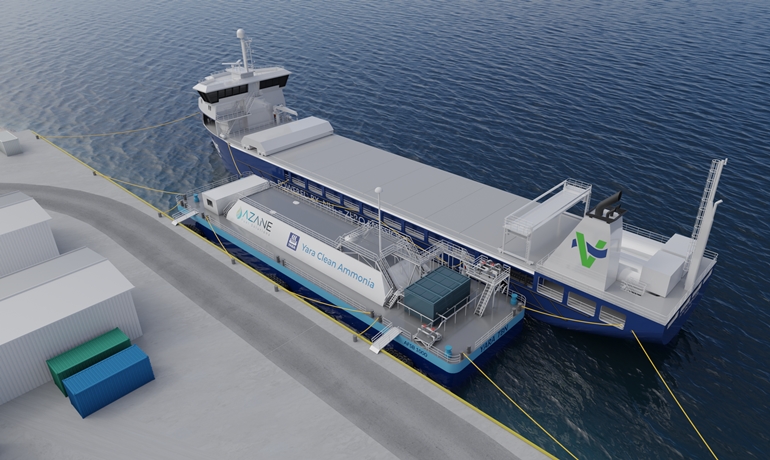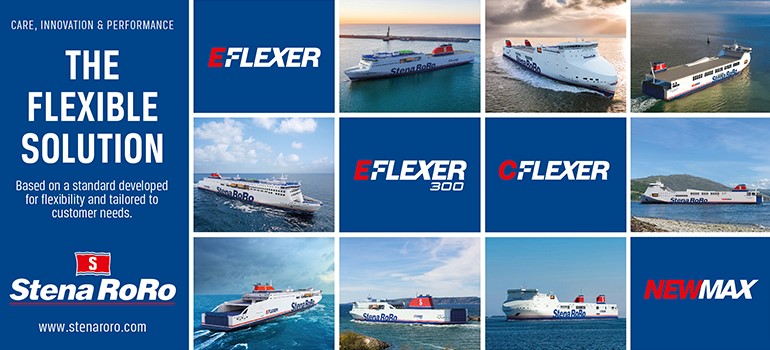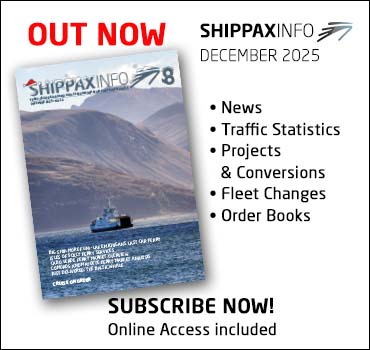
Yara is part of a consortium that is developing a first ammonia bunkering terminal in Norway.© Azane Fuel Solutions
Emerging ammonia bunkering network set to fuel carbon-neutral ambitions
A global bunkering network for ammonia is being brought to fruition by Yara as newbuild orders for multi-fuel vessels by the likes of Höegh Autoliners are set to increase uptake of the carbon-neutral fuel.
Yara, which has traditionally produced ammonia for its core business of fertiliser production, has set up its Clean Ammonia unit that is working together with industry players including class society DNV, shipowners and engine manufacturers to boost the availability of ammonia as a shipping fuel.
“Yara is in a unique position as it already has the necessary logistics in place for ammonia with an existing end-to-end value chain comprising production infrastructure, shipping and storage facilities. We are also the world’s largest trader of ammonia,” Yara Clean Ammonia’s (YCA) director for bunkering market development Christian Berg said.
“The missing link in the value chain is bunkering facilities and we are now working with the industry to develop fuel terminals as well as ship-to-ship transfer of ammonia for larger vessels,” he told a recent Immediasea webinar focusing on fuel flexibility, hosted by Blue-C with Fathom World.
Ammonia availability
Berg also challenged conventional industry wisdom that availability is one of the biggest barriers to adoption of ammonia as an alternative fuel to meet IMO emissions targets.
“There are today 130 ports globally that have ammonia infrastructure, so grey ammonia is already being traded as a cargo and using it as fuel is only a question of certification. We are well on the way to making it available as a fuel,” he said.
Yara has mainly produced grey ammonia made from natural gas in recent years but is now pursuing several projects for production of blue ammonia - in which CO2 is captured and stored - and green ammonia that is produced with water using electrolysis.
The Norwegian company originally started producing green ammonia, which is essentially carbon-free, way back in 1927 but shifted to grey ammonia in the 1990s due to the availability of cheap gas before CO2 emissions became a big issue. Yara now produces 8.5 million tonnes of ammonia annually at 17 plants.
First terminal
YCA is part of a consortium that is developing a first ammonia terminal in Norway set to be operational in 2024, backed by funding of Nkr89 million from the country’s so-called Green Platform, and Berg says it has “a global perspective” for development of a wider bunkering network.
The bunkering infrastructure technology is being developed by Azane Fuel Solutions, a joint venture between Amon Maritime and Econnect Energy that are both partners in the consortium for the so-called Ammonia Fuel Bunkering Network project.
The Yara unit is also set to deliver green ammonia for the ShipFC project involving the world’s first vessel to use ammonia fuel cells and for another with Viridis Bulk Carriers that involves a partnership between seven cargo owners.
Berg sees the first ammonia-fuelled vessels being on the water in 2024 or 2025 given current tests that are ongoing by engine manufacturers for use of the fuel. And he does not rule out that ammonia could soon compete with LNG as the low-carbon alternative fuel of choice.
Ammonia, together with hydrogen, biofuels and e-fuels, are ranked by DNV as having the strongest green credentials as they can reduce emissions by between 80% and 100%. But there are also barriers to adoption in terms of availability, cost and maturity of technology.
DNV’s regional business development manager Anders Mikkelsen told the Immediasea panel “the fuel landscape is highly uncertain” as key future fuel technologies will not be available for another four to eight years so “shipowners need to be prepared for several fuel alternatives”.
Collaboration factor
Given the IMO’s demand for increasing reductions in emissions over the coming years, this makes it difficult for shipowners to select the right fuel option at the newbuilding stage to ensure the vessel is future-proof in terms of compliance, he said.
"Basic preparation at the ship design and newbuild stages is therefore important to buy time to allow for flexibility down the line when there is more clarity on price, availability, quality and capacity of future fuels.
“The key is to correctly assess the technology, fuel production and supply infrastructure to stay under the carbon reduction trajectory.
“And in the context of fuel flexibility, collaboration is vital both between shipowners and manufacturers as well as fuel suppliers, which enables more confident decision-making. Those who choose the path of collaboration are farthest along on their decarbonisation journey.”
Höegh Autoliners is among shipowners taking a forward-thinking approach by pursuing multi-fuel newbuilds, having recently ordered an initial four of what will be the world’s largest PCTCs (pure car and truck carriers), with options for eight similar vessels, at China Merchants Heavy Industry.
Design effort
The Deltamarin-designed Aurora-class vessels with capacity of 9100-ceu, set for delivery in 2024 and 2025, will be capable of running on liquid fuels, LNG and biofuels, and will also be the first newbuilds with DNV’s ammonia- and methanol-ready class notations.
The company envisages these vessels could be converted to ammonia or other net-zero fuels in the 2025-to-2030 timeframe.
Höegh chief executive Andreas Enger characterised these as “a definitive step” towards the company’s goal of reaching net zero emissions from its fleet of deepsea car carriers by 2040. It has already cut emissions per CEU nautical mile by 37% since 2008 and has a current carbon intensity 10% lower than average for its segment.
“We have put a lot of effort into the design of these vessels to build strong conventional economics, with high capacity and strengthened decks for heavier electric vehicles, as well as fuel flexibility. Given the age profile of these vessels, this is well-fitted to where the world is going,” he said.
Decarbonisation payback
Deltamarin’s sales & marketing director Esa Jokioinen said shipowners would be well-advised to consider at the newbuilding design stage multiple factors - such as operational profile, trade route, cargo type, current and future regulations, and fuel availability - to optimise the hull, layout and engine selection.
Designing with fuel flexibility so a vessel can easily be converted for alternative fuels as these become available is also key to future-proofing a newbuild investment, according to Jokioinen.
“Looking at the different requirements in the beginning and investing in the best design usually gives the best payback for any decarbonisation action,” he said.
But the days when shipowners could choose a simple commoditised fuel solution for their vessels are apparently long gone. “There is no silver bullet, though everyone is still hoping for it,” he said.
apr 26 2022
Most read
Scottish government to nationalise Ardrossan Harbour and carry out major upgrading programme to be able to dock new CalMac ferries
jan 09 2026
Indonesian ferry wrecked in the Sunda Strait
jan 08 2026

















